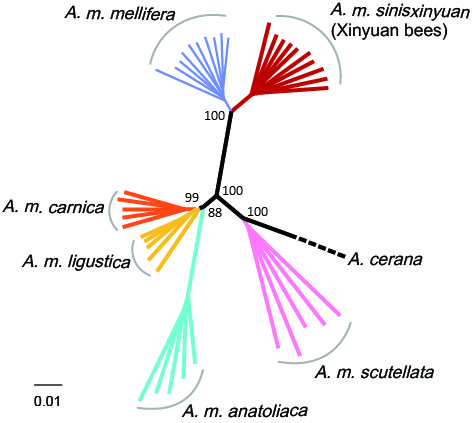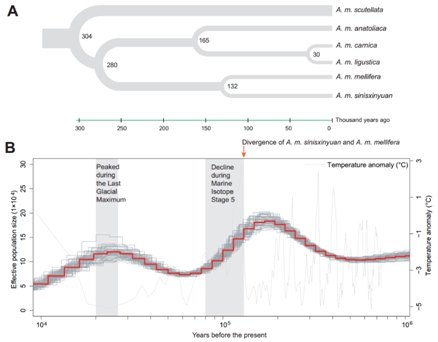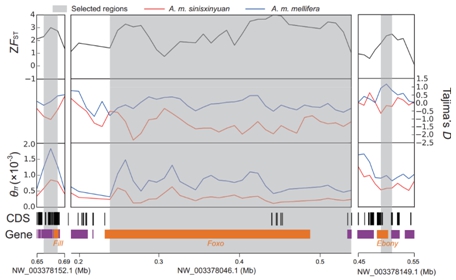分享到
Adaptation to Temperate Climates in Honey Bees Revealed by a New Subspecies in China
Recently, a team led by Dr. Wei Shi from the Institute of Apicultural Research (IAR) of the Chinese Academy of Agricultural Sciences (CAAS) made significant progress on understanding genetic resources and adaptation of honey bees (Apis mellifera) in China. Their findings were published in Molecular Biology and Evolution (5-Year Impact Factor: 15.667) in Feb. 2016.
The western honey bee (Apis mellifera) is an interesting species to study climate-driven adaptation because it originated in tropical/subtropical climatic regions and subsequently spread into temperate regions. However, little is known about the genetic basis of its adaptation to temperate climate. The study reports the first discovery of Apis mellifera population in China, extending the eastern boundary of the distribution of Apis mellifera into western China. Employing a population genomic approach, researchers designated the population as a new subspecies of honey bee (Apis mellifera sinisxinyuan), and found that long-term global temperature has strongly influenced its demographic history and divergence from other subspecies. The study also identified a series of genes related to fat body and the Hippo signaling pathway that are potentially involved in adaptation to temperate climates. These findings will facilitate the selective breeding of A. mellifera to improve the survival of overwintering colonies.

Fig. 1 Phylogenetic tree of honey bee populations.

Fig. 2 Population genetics and demographic history. (A) Time of divergence between populations in thousands of years. (B) Demographic history of A. m. sinisxinyuan.

Fig. 3 Examples of genes with strong selective sweep signals in A. m. sinisxinyuan and A. m. mellifera.
The western honey bee (Apis mellifera) is an interesting species to study climate-driven adaptation because it originated in tropical/subtropical climatic regions and subsequently spread into temperate regions. However, little is known about the genetic basis of its adaptation to temperate climate. The study reports the first discovery of Apis mellifera population in China, extending the eastern boundary of the distribution of Apis mellifera into western China. Employing a population genomic approach, researchers designated the population as a new subspecies of honey bee (Apis mellifera sinisxinyuan), and found that long-term global temperature has strongly influenced its demographic history and divergence from other subspecies. The study also identified a series of genes related to fat body and the Hippo signaling pathway that are potentially involved in adaptation to temperate climates. These findings will facilitate the selective breeding of A. mellifera to improve the survival of overwintering colonies.

Fig. 1 Phylogenetic tree of honey bee populations.
More details are available on the links bellow:
http://mbe.oxfordjournals.org/content/early/2016/02/20/molbev.msw017
http://mbe.oxfordjournals.org/content/early/2016/02/20/molbev.msw017

Fig. 2 Population genetics and demographic history. (A) Time of divergence between populations in thousands of years. (B) Demographic history of A. m. sinisxinyuan.

Fig. 3 Examples of genes with strong selective sweep signals in A. m. sinisxinyuan and A. m. mellifera.
By Chen Chao
chenchaoiar@163.com
chenchaoiar@163.com
Latest News
-
 Apr 18, 2024Opening Ceremony of the Training Workshop on Wheat Head Scab Resistance Breeding and Pest Control in Africa Held in CAAS
Apr 18, 2024Opening Ceremony of the Training Workshop on Wheat Head Scab Resistance Breeding and Pest Control in Africa Held in CAAS -
 Apr 03, 2024IPPCAAS Co-organized the Training Workshop on Management and Application of Biopesticides in Nepal
Apr 03, 2024IPPCAAS Co-organized the Training Workshop on Management and Application of Biopesticides in Nepal -
 Mar 28, 2024Delegation from the School of Agriculture and Food Science of University College Dublin, Ireland Visit to IAS, CAAS
Mar 28, 2024Delegation from the School of Agriculture and Food Science of University College Dublin, Ireland Visit to IAS, CAAS -
 Mar 25, 2024Director of World Food Prize Foundation visited GSCAAS
Mar 25, 2024Director of World Food Prize Foundation visited GSCAAS -
 Mar 20, 2024Institute of Crop Sciences (ICS) and Syngenta Group Global Seeds Advance Collaborative Research in the Seed Industry
Mar 20, 2024Institute of Crop Sciences (ICS) and Syngenta Group Global Seeds Advance Collaborative Research in the Seed Industry
